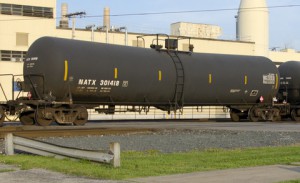 The string of oil by rail accidents in recent weeks has forced regulators in both Canada and the US to re-appraise the safety of oil by rail.
The string of oil by rail accidents in recent weeks has forced regulators in both Canada and the US to re-appraise the safety of oil by rail.
The oil by rail industry now has a month to draw up new plans that will limit the increasing number of accidents.
However these proposed “voluntary measures” are unlikely to satisfy the growing number of communities who are extremely concerned about the increasing frequency of oil by rail accidents. For more see my previous blog this month.
There is concern on both sides of the border. Last week, experts from both the American and Canadian rail and oil industry met regulators and government officials to discuss the recent oil by rail disasters which have exposed glaring flaws in the oversight system.
According to reports in the press, under urgent discussion is the safety of what is known as DOT-111 tank cars. They are the standard, near-ubiquitous cylindrical cars operating in North America.
If you live near a rail-road in North America, chances are that you will have seen huge trains of these tank cars trundle pass you – some 80 per cent of the Canadian fleet and 70 per cent of the US fleet are this type.
Designed to carry a whole host of liquids, they are non-pressurised. Their increasing use is now under intense scrutiny. As CNBC reported last week: “The main concern with the tank cars is their tendency to puncture in the event of a crash.”
What has also become extremely apparent is that transporting fracked oil has become a big problem. This shale oil has more Volatile Organic Compounds in it compared to normal crude and is therefore more flammable and explosive.
Transport Canada is so concerned about the potential weaknesses of the DOT-111 that it recently announced that all new cars will have to be built with thicker steel, but will this alone solve the problem?
Firstly, the proposed change does not call for retrofitting any tank cars. And anyway, retrofitting is unlikely to happen, firstly due to the cost and secondly due to intense lobbying by the owners of the tank cars, 99 per cent of whom are American petrochemical companies.
According to research undertaken for the Canadian Transportation Research Forum, retrofitting Canada’s 45,000 tanker cars would cost over $1 billion.
Just as Canadian officials have become concerned, last Thursday US officials called on the oil industry to come up with safer ways to transport oil on the railways. After meeting oil industry and rail car executives, Transportation Secretary Anthony Foxx said the industry had agreed to make “voluntary changes” aimed at reducing accidents within 30 days.
These changes are likely to include reducing the speed of the trains and potentially avoiding large metropolitan areas.
But US-based safety specialists argue that the proposed measures do not resolve crucial and longstanding problems with the tank cars, which is that many are defective.
Furthermore these measures are not satisfying the industry’s critics: “Just moving the problem around is not solving it,” Karen Darch, president of the village of Barrington, in Illinois who chairs a coalition of local officials advocating enhanced rail safety measures told the Associated Press. “If you did that, you are creating too high a risk for the area where (oil trains) might be rerouted.”
Ironically even the oil industry has criticised the regulators, with the American Petroleum Institute calling on the Department of Transportation to “take action” and “to do more than just host meetings.”
And with perfect timing to just remind everyone that transporting oil by pipeline is not safe either.
Enbridge, which wants to build the highly controversial Northern Gateway pipeline to export the tar sands, reported a small spill in its 450,000 barrel-per-day Alberta Clipper pipeline over the weekend near Saskatchewan in Canada.
Although only 125 barrels was reportedly spilt, it is a reminder of the risks of transporting oil by pipeline too.
The company and regulators are currently investigating the cause of the incident.
